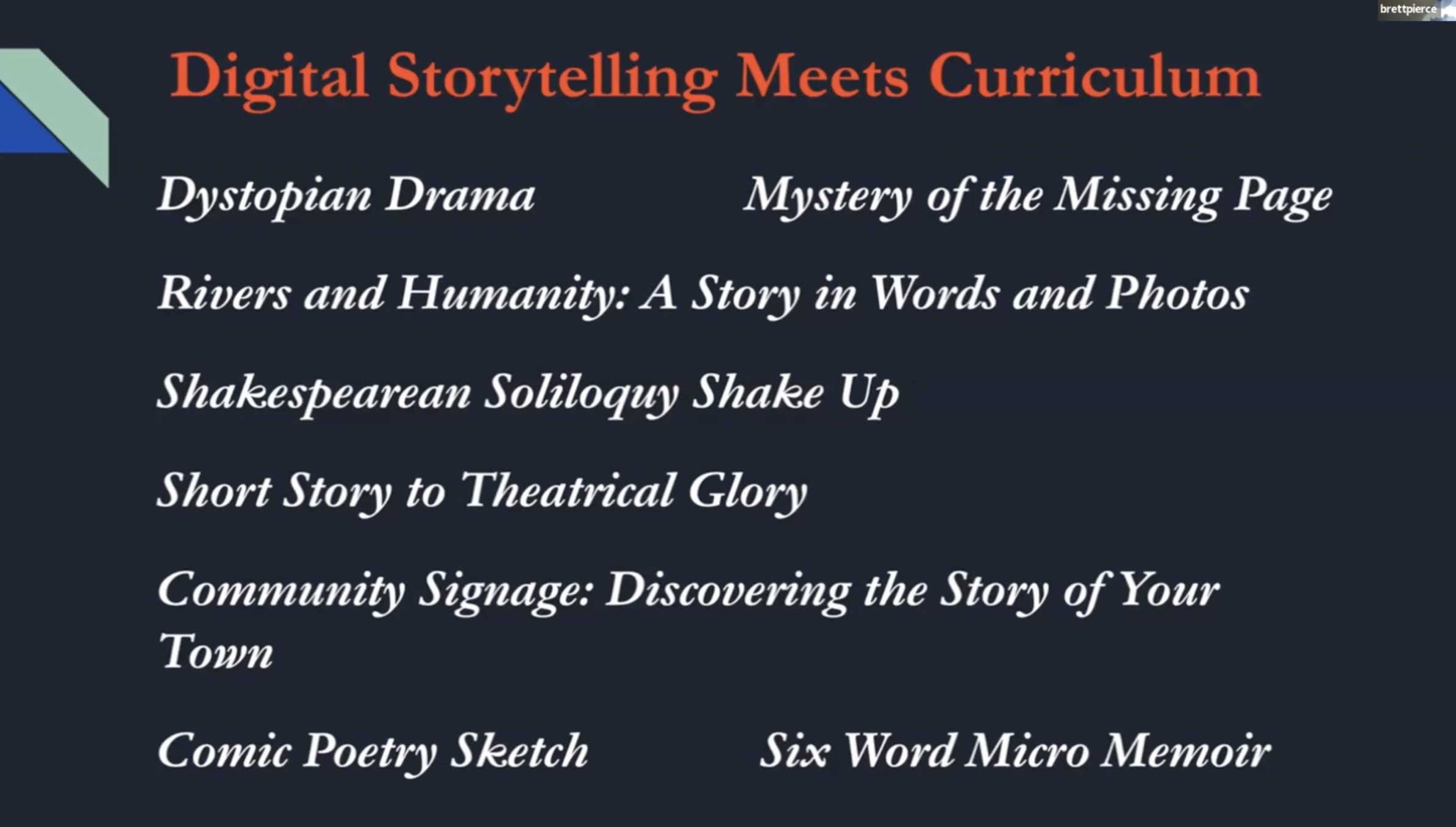Digital Storytelling: An Impactful, Creative, and Collaborative Student Activity
On February 15, The SPARC Symposium opened with a fascinating keynote presentation by Brett Pierce, the Founder and Director of Meridian Stories and author of Expanding Literacies: Bringing Digital Storytelling into Your Classroom. In a talk that centered the profound importance of digital media in the lives of young people, Pierce helped us understand what digital storytelling is, why it is so impactful, and how to leverage students’ engagement with the digital world to create activities that are fun as well as valuable learning experiences.
What is digital storytelling?

Pierce defines digital storytelling as “the capacity to communicate using text, sound, music, and imagery--still and moving.” Platforms include:
- Audio forms such as podcasts and online music streamers like Spotify and Pandora
- Texting and emojis used on phones and apps stand in for oral communication
- Short videos found on platforms like YouTube, Vimeo, and TikTok
- Social media interactions on Twitter (X), Facebook, Instagram, TikTok, etc.
In the United States, digital storytelling started with the producers of Sesame Street realizing they could “sell” education to kids—counting, spelling, basic Spanish—by writing stories featuring characters with whom the kids could identify. They understood that when children identify with and connect to a character in a story, they will shift their behavior according to that connection.
Pierce himself worked with digital storytelling in Iraq 10-15 years ago. When the country implemented democratic elections, a brand new experience for young Iraqis, he helped create a reality show where young people competed in a variety of games that prepared them for civic participation in a democracy. Viewers saw them learning these ideas and even watched them vote in the same way they would in an actual election—by placing a paper ballot in a box.
Why is digital storytelling important?

Digital storytelling has evolved to be one of the primary ways kids engage with the world. Pierce offered the example of a vlog, or video journal, that you might see on YouTube. When a student makes a short video talking about their challenges, their frustrations, and their joys, the kids watching feel a connection with that person. It’s personal, feels authentic, and can feel safer than talking to a therapist or a parent. It offers a kid-to-kid interaction that provides a genuine social and emotional connection. Psychologist have recognized the positive therapeutic effects of this kind of parasocial relationship.
How can digital storytelling be used in the classroom?

While writing a paper about a Shakespeare play can feel tedious and boring, students find that creating a digital story based on a Shakespeare play can be fun.
Pierce notes one primary difference between these two projects: writing a paper doesn’t require prior knowledge. An individual student researches what they need for the paper, then writes the paper. Digital storytelling, however, requires a variety of skills and knowledge before the real work even begins.
Imagine a group working together to make a short video that reimagines a scene from Shakespeare set in the modern day. Before filming begins, they students must:
- Choose who will do which tasks—writing, producing, filming, acting, filming, etc.
- Write the story
- Storyboard the film they wish to make
- Decide where to film and build the set, if necessary
- Obtain any needed props or costumes
- Learn their lines, if acting
This creates a highly collaborative process in which students need to acquire all the necessary skills to begin the actual filming. They also must also resolve any conflicts while learning to share and implement their collective knowledge.
Pierce emphasizes that the finished product is not the point: it’s the process that matters. After a student writes a paper, the teacher assigns it a grade, which is an interaction between one student and the teacher. But when creating a digital story, the collaboration itself is the point—making a myriad of decisions together, acquiring skills, learning how to communicate and work as a team, and engaging with the Shakespeare text. Here, the students interact with their peers and with the teacher as a resource.
Why does digital storytelling have such a strong impact on young people?

Pierce says that kids today live about half their lives in the digital world and half “in the present,” that is, interacting face to face with other people. He gives the example that in 2022, “on average, 500 hours of content was uploaded on YouTube every minute.” That’s a tremendous amount of digital engagement.
Much of the life of a young person exists in what Pierce calls the “digital universe," a “full-blown communication spectrum the breadth and depth of which is unprecedented.” Kids use digital platforms to communicate, to engage socially, to gain knowledge, and to spend free time with music, podcasts, and videos. It is, Pierce says, an “absolutely necessary literacy without which they cannot survive.” This is how profoundly significant the digital world has become.
Perhaps the most important aspect of creating digital stories is the personal input it requires from the creators. Pierce emphasizes how it helps kids develop their own voice at a time when they’re just learning how to do that. Creating these stories requires that they put something of themselves into whatever they make. It shows them that they have something to say and gives them a means to say it. The ability to do this through digital storytelling will only become more and more essential as they grow into adults.
The SPARC Symposium is a signature virtual event designed to elevate your leadership skills and your auxiliary programs. Strategic conversations led by independent school and nationally recognized thought leaders each year focus on themes such as transformational leadership, diversity, equity, and inclusion and youth programming design for the future. To learn more, click here.
